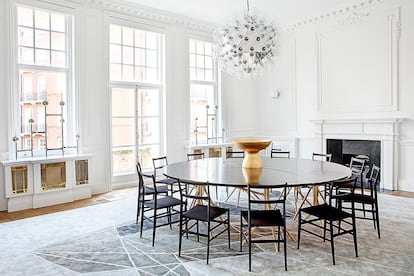Minimalism or exhibitionism? Here come curtain-less windows
A new marker of social status has risen above: huge, completely naked windowpanes, stripped-down showcases of private life

A new marker of social status has risen above: huge, stunning windows made of fine materials, but totally naked of curtains and that showcase the private life of the owners of renovated apartments in the gentrified areas of the world’s great capitals. The New York Times reports on Brooklyn Heights’ obligatory uncurtained windows, describing them as “ethnological dioramas” of white and millennial inhabitants of the West Village and Park Slope. The Guardian has found them on the stately apartments of West London, and TikTok has made viral content of them. The hashtags #NakedWindows and #staresinrichpeoplewindowsnyc are among the most popular in Manhattan, bringing together the TikTokers who take to the streets with real anthropological interest in spying, through such windows, on the lives of their rich neighbors in order, so they say, to copy their decorating acumen. In some videos the owners even appear, proud and smiling, through their vast, naked panes.
Curtain-less windows allow passers-by to see open-plan spaces with a scattering of expensive pieces. Their neighbors would surely call it showing off: luxurious grand pianos, a Jeff Koons dog, a pair of Togo sofas, a Technogym elliptical trainer, huge solid marble kitchen islands and a silver chandelier. Everything in order. A pet, perhaps a Persian cat or Afghan greyhound, might complete the scene.
The fourth season of Succession (HBO), the series that delved into the social codes of the contemporary upper class, summed up in Loro Piana baseball hats and Brunello Cucinelli vicuña sweaters, also had its ultra-rich and terrible characters living the curtain-less lifestyle. There was Shiv Roy (Sarah Snook) in her magnificent 35-window loft, where apparently only the bedroom and bathrooms were opaque. Her older brother Kendall (Jeremy Strong), resident of the Upper West Side, inhabits a luxurious penthouse with views of Manhattan unencumbered by a single window covering.
Several isms have been wielded to theorize on the trend. The most classic and antique explanation is that of Calvinism, which explains why, in cities like Amsterdam, the practice is nothing new. According to its precepts, a good family has nothing to hide — and in this light, a curtain may even appear suspicious. Another explanation for the curtain purge is minimalism and its hunt for light, clean spaces that promote tranquility and harmony.
Exhibitionism and the stealth marking of wealth is the third explanation. According to observers of this phenomenon, silent luxury rules the world and, just as in fashion, works through coded language. It’s not obvious, and only a few people hold the keys to its decoding. Obviously, this does not refer to the Jeff Koons dog atop a marble slab, but rather turning off lights in rooms with Forbes & Lomax toggles, elegant 1930 devices made in bronze, nickel and brass which, according to interior designers are “the crown jewels.” Recognizing these absurdly expensive switches is not within reach of the neophyte. The same might be said of structures and enclosures that are left uncovered.
In 2013, a study by the U.S. Department of Energy had already linked family wealth with the decision to live with bare windows. According to the report, U.S. residents who earned more than $150,000 a year were two times more likely to live without curtains that those who made between $20,000 and $29,000. A decade later, such numbers have given rise to a generation of young people who live in gentrified urban areas in the country.
Daniel Jütter is a professor in the department of history of New York University and author of the book Transparency: The Material History of an Idea, in which he attempts to demonstrate that that human history of transparency is closely linked to one of the key elements of Western architecture: glass windows. “I don’t know if naked windows are a worldwide trend, but they are in New York, where I live,” he says via email, continuing, “The Dutch have turned their uncovered windows into a national legend, although I think that has to do with a 20th-century phenomenon that has been attributed to the Protestant legacy. Personally, I’m skeptical in regards to that theory, since in the majority of modern megacities, windows without curtains form part, more than anything else, of the logic of the visualization of status.”

The Farnsworth house, built in 1945 by Ludwig Mies van der Rohe as a second house for Doctor Edith Farnsworth, is perhaps one of the most radical experiments in transparency. With its legendary open-plan floor and transparent walls, its creator sought to establish a reconnection with nature through the use of glass that brought together the residence’s interior and exterior. To Frank Gehry is attributed the quote, “If someone lived in the Farnsworth house, they would wake up in the morning and pick up all their clothes from the floor. They’d be careful where they leave their stuff.”
Professor Jütter notes a “certain global infatuation” with transparent facades and huge glass windows. “I think that our contemporary mantra of the social concept of transparency is backed up by the mass, large-scale experience of transparency as material and architectural reality,” he writes in his email.
Still, designer Nicholas Korody, author of Uses of Decorating, a collection of four essays, proposes a different reading: “Today, in general terms, the ultra-rich hide their wealth, while the bourgeois classes, or those who wish to be them, take on an ostentatious consumption through social media. If there is really a performative dimension in the lack of curtains, we should invert our reading of its function, because the window has become anachronistic as a device that delimits the private from the public, the ubiquitous presence of cameras has shattered that idea,” he says via email.
Francesca Sapey, of the studio Teresa Sapey + Partners, is starting to see more projects that feature bare windows. “We have more and more houses where the curtain disappears,” she says in a conversation with EL PAÍS. “We chalk it up to the digitalization of life, which exposes so much on social media, dilutes the barriers between the public and the private, and makes us want diaphanous, open residences where spaces are no longer so defined.”
That hasn’t been the experience of the Spanish interior designers and architects who were consulted for this article, who believe that the trend will take longer to arrive to their country. Some even believe that it never will. “If removing curtains is in style, we didn’t realize it, but we certainly don’t see it as being very popular here, where we are stingy with our privacy and don’t understand private space as an extension of our moral qualities, as happens in Protestant cultures,” says Pablo López of Casa Josephine Studio, adding: “Our clients still need curtains to ensure their privacy and to add color, richness and variety in textures. We are intrigued and unsettled by the subject. If a client of ours asked us to take down the curtains, we’d ask them why, and possibly not see eye to eye.”
María Villalón, founder of Villalón Studio, considers it “a strange trend,” but allows that in “more architectural projects they remove curtains to maximize the mock-ups and exterior structures.” “In general, I continue to use them to dress spaces and ensure privacy. My clients don’t want views from outside,” she says. Interior designer Belén Domecq shares this opinion.
“It’s true that ultimately, curtains function almost as an installation with character, like an architectural element per se,” says Ricard Trenchs of Trenchs Studio, adding: “Not putting up curtains is a decision that maximizes the beauty of modern architecture.” Trenchs believes that the desire to show off interiors only happens in the case of those who want “the interior to function as a showcase of life.” “I don’t think that’s common right now in Spain,” he says.
The desire to live in a kind of showroom that barely hides a less obvious, stealthy wealth that stimulates the imagination and indiscreet looks from passers-by fits into another practice that seems modern but isn’t, really: an at-times unhealthy curiosity about the life, work, grace and misfortune of the upper class. It’s called wealth porn. Economist Nicholas Bloom, Stanford University professor, sums it up in a single phrase: “Collectively, we are spending more time checking up on how the rich and famous are living than we are on finding out what our friends did last weekend.” If the elite take down their curtains, they’re making the process even easier.
Sign up for our weekly newsletter to get more English-language news coverage from EL PAÍS USA Edition
Tu suscripción se está usando en otro dispositivo
¿Quieres añadir otro usuario a tu suscripción?
Si continúas leyendo en este dispositivo, no se podrá leer en el otro.
FlechaTu suscripción se está usando en otro dispositivo y solo puedes acceder a EL PAÍS desde un dispositivo a la vez.
Si quieres compartir tu cuenta, cambia tu suscripción a la modalidad Premium, así podrás añadir otro usuario. Cada uno accederá con su propia cuenta de email, lo que os permitirá personalizar vuestra experiencia en EL PAÍS.
¿Tienes una suscripción de empresa? Accede aquí para contratar más cuentas.
En el caso de no saber quién está usando tu cuenta, te recomendamos cambiar tu contraseña aquí.
Si decides continuar compartiendo tu cuenta, este mensaje se mostrará en tu dispositivo y en el de la otra persona que está usando tu cuenta de forma indefinida, afectando a tu experiencia de lectura. Puedes consultar aquí los términos y condiciones de la suscripción digital.
More information
Archived In
Últimas noticias
The complicated life of Francesca Albanese: A rising figure in Italy but barred from every bank by Trump’s sanctions
How Japan is trying to avert ‘digital defeat’
Half of Scotland is in the hands of 420 property owners
Reinhard Genzel, Nobel laureate in physics: ‘One-minute videos will never give you the truth’
Most viewed
- Pablo Escobar’s hippos: A serious environmental problem, 40 years on
- Reinhard Genzel, Nobel laureate in physics: ‘One-minute videos will never give you the truth’
- Why we lost the habit of sleeping in two segments and how that changed our sense of time
- Charles Dubouloz, mountaineering star, retires at 36 with a farewell tour inspired by Walter Bonatti
- The Florida Keys tourist paradise is besieged by immigration agents: ‘We’ve never seen anything like this’











































